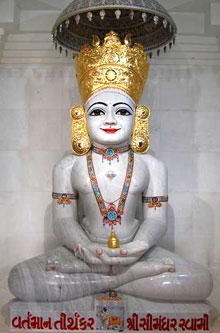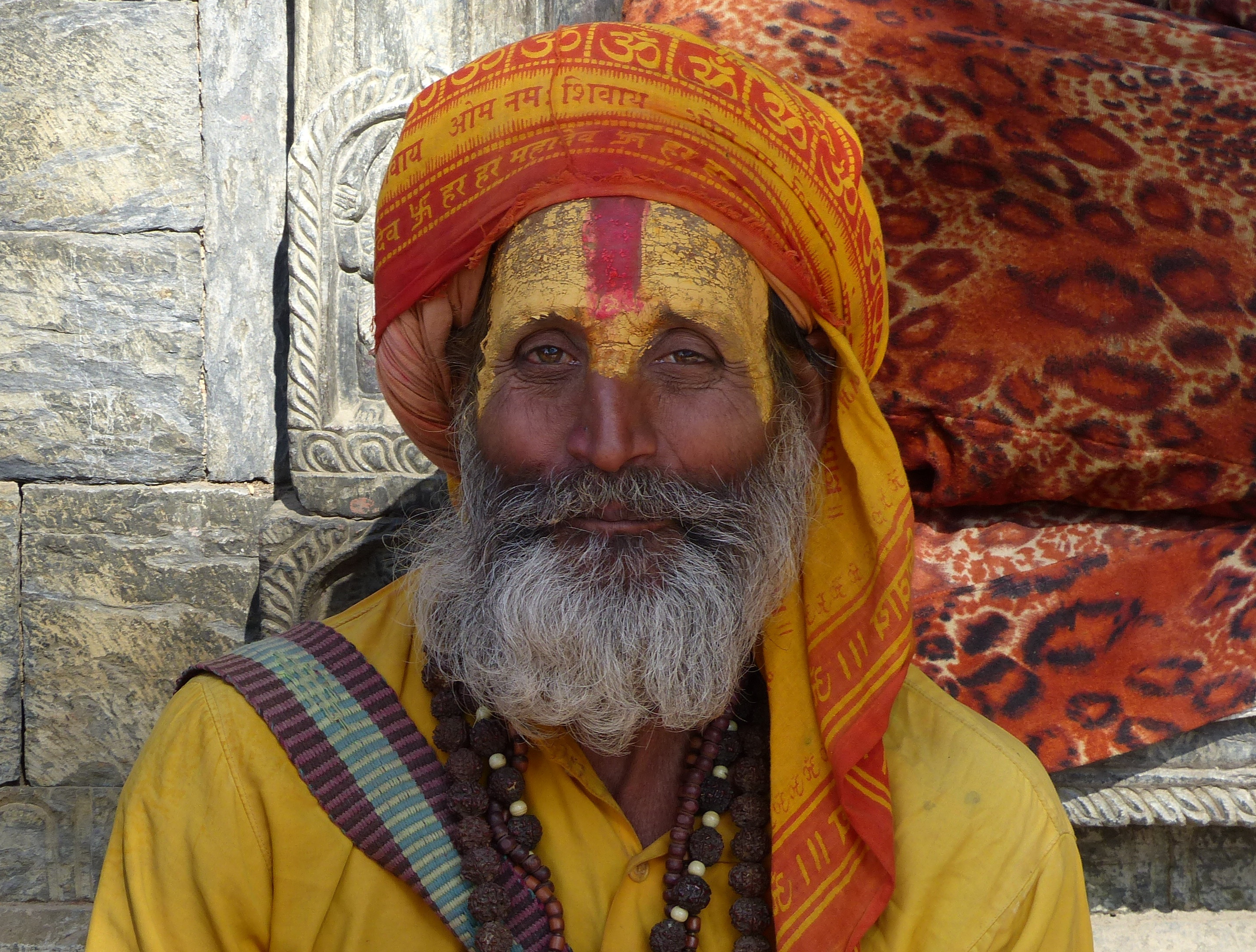|
Muhapatti
The muhapatti (variously spelled mahapatti, muhpatti or mahpatti) is a square of white cloth worn across the face and tied behind the ears or held, by Sthanakvasi Svetambara or Śvētāmbara Terapanthi Jains. Sometimes a card is used instead of a cloth. The purpose is to prevent saliva from coming into contact with sacred books, images or other items. It is often purported to be worn to reduce the chance of inhaling (and thus killing) small insects and other airborne life. Some Jains believe the destruction of even these tiny life forms is a violation of ahimsa, the principle of non-violence. Whilst this may be one benefit of the use of muhapatti, it is not the initial reason for use. It is one of the accessories of sadhu in the practise of Dharma. It is one of many "health-giving concepts" woven into the Jain belief system. Murtipujaka Mūrtipūjaka (lit. "image-worshipper"), also known as Derāvāsī ("temple-dweller") or Mandir Mārgī ("follower of the temple path" ... [...More Info...] [...Related Items...] OR: [Wikipedia] [Google] [Baidu] |
Murtipujaka
Mūrtipūjaka (lit. "image-worshipper"), also known as Derāvāsī ("temple-dweller") or Mandir Mārgī ("follower of the temple path"), is the largest sect of Śvētāmbara, Śvetāmbara Jainism. Mūrtipūjaka Jains differ from both Śvetāmbara Sthānakavāsī and Śvetāmbara Terāpanthī Jains in that they worship images of the Tirthankara, Tīrthaṅkaras. Mūrtipūjaka may also generally describe members of both the Śvetāmbara and Digambara traditions who use idols (''Murti, mūrti'') in their worship (''pūjā''). Agreements and disagreements According to Nalini Balbir, all Śvetāmbara sects agree upon "the authority of the Śvetāmbara canonical scriptures, with slight differences; claims of monastic descent from Sudharmaswami, Sudharman, except for the Upakeśa-gaccha; [and] white monastic robes [for] monks and nuns." However, despite these commonalities, a central division exists between each of the sects as related to the use of images in worship. Indeed, the e ... [...More Info...] [...Related Items...] OR: [Wikipedia] [Google] [Baidu] |
Acharya Mahapragya
In Indian religions and society, an ''acharya'' ( Sanskrit: आचार्य, IAST: ; Pali: ''ācariya'') is a preceptor and expert instructor in matters such as religion, or any other subject. An acharya is a highly learned person with a title affixed to the names of learned subject. The designation has different meanings in Hinduism, Buddhism and secular contexts. ''Acharya'' is sometimes used to address an expert teacher or a scholar in any discipline, e.g.: Bhaskaracharya, the expert mathematician. Etymology The Sanskrit phrase ''Acharam Grahayati Acharam Dadati Iti Va'' means ''Acharya'' (or teacher) is the one who teaches good conduct to one's students. A female teacher is called an ''achāryā,'' and a male teacher's wife is called an ''achāryāni'' In Hinduism In Hinduism, an ''acharya'' is a formal title of a teacher or guru, who has attained a degree in Veda and Vedanga. Prominent acharyas in the Hindu tradition are as given below : * Adi Sankaracharya * ... [...More Info...] [...Related Items...] OR: [Wikipedia] [Google] [Baidu] |
Jainism
Jainism ( ), also known as Jain Dharma, is an Indian religions, Indian religion. Jainism traces its spiritual ideas and history through the succession of twenty-four tirthankaras (supreme preachers of ''Dharma''), with the first in the current time cycle being Rishabhadeva, whom the tradition holds to have lived millions of years ago, the twenty-third ''tirthankara'' Parshvanatha, whom historians date to the 9th century BCE, and the twenty-fourth ''tirthankara'' Mahāvīra, Mahavira, around 600 BCE. Jainism is considered to be an eternal ''dharma'' with the ''tirthankaras'' guiding every time cycle of the Jain cosmology, cosmology. The three main pillars of Jainism are ''Ahimsa in Jainism, ahiṃsā'' (non-violence), ''anekāntavāda'' (non-absolutism), and ''aparigraha'' (asceticism). Jain monks, after positioning themselves in the sublime state of soul consciousness, take five main vows: ''ahiṃsā'' (non-violence), ''satya'' (truth), ''Achourya, asteya'' (not stealing), ''b ... [...More Info...] [...Related Items...] OR: [Wikipedia] [Google] [Baidu] |
Ahimsa
Ahimsa (, IAST: ''ahiṃsā'', ) is the ancient Indian principle of nonviolence which applies to all living beings. It is a key virtue in most Indian religions: Jainism, Buddhism, and Hinduism.Bajpai, Shiva (2011). The History of India – From Ancient to Modern Times', Himalayan Academy Publications (Hawaii, USA), ; see pages 8, 98 Ahimsa is one of the cardinal virtues of Jainism, where it is the first of the Pancha Mahavrata. It is also the first of the five precepts of Buddhism. ''Ahimsa'' is a multidimensional concept,John Arapura in K. R. Sundararajan and Bithika Mukerji Ed. (1997), Hindu spirituality: Postclassical and modern, ; see Chapter 20, pages 392–417 inspired by the premise that all living beings have the spark of the divine spiritual energy; therefore, to hurt another being is to hurt oneself. ''Ahimsa'' is also related to the notion that all acts of violence has karmic consequences. While ancient scholars of Brahmanism already investigated and refined th ... [...More Info...] [...Related Items...] OR: [Wikipedia] [Google] [Baidu] |
Sadhu
''Sadhu'' ( sa, साधु, IAST: ' (male), ''sādhvī'' or ''sādhvīne'' (female)), also spelled ''saddhu'', is a religious ascetic, mendicant or any holy person in Hinduism, Buddhism, and Jainism who has renounced the worldly life. They are sometimes alternatively referred to as '' yogi'', ''sannyasi'' or ''vairagi''. Sadhu means one who practises a ' sadhana' or keenly follows a path of spiritual discipline.″Autobiography of an Yogi″, Yogananda, Paramhamsa, Jaico Publishing House, 127, Mahatma Gandhi Road, Bombay Fort Road, Bombay (Mumbai) - 400 0023 (ed.1997) p.16 Although the vast majority of sādhus are yogīs, not all yogīs are sādhus. A sādhu's life is solely dedicated to achieving mokṣa (liberation from the cycle of death and rebirth), the fourth and final aśrama (stage of life), through meditation and contemplation of Brahman. Sādhus often wear simple clothing, such as saffron-coloured clothing in Hinduism and white or nothing in Jainism, symbolisi ... [...More Info...] [...Related Items...] OR: [Wikipedia] [Google] [Baidu] |
Dharma
Dharma (; sa, धर्म, dharma, ; pi, dhamma, italic=yes) is a key concept with multiple meanings in Indian religions, such as Hinduism, Buddhism, Jainism, Sikhism and others. Although there is no direct single-word translation for ''dharma'' in European languages, it is commonly translated as "righteousness", "merit" or "religious and moral duties" governing individual conduct.Britannica, The Editors of Encyclopaedia. (9 April 2019)Dharma. ''Encyclopedia Britannica''. Accessed 14 September 2021. In Hinduism, dharma is one of the four components of the ''Puruṣārtha'', the aims of life, and signifies behaviours that are considered to be in accord with '' Ṛta'', the order that makes life and universe possible. It includes duties, rights, laws, conduct, virtues and "right way of living".see: *"Dharma", ''The Columbia Encyclopedia'', 6th Ed. (2013), Columbia University Press, Gale, ; *Steven Rosen (2006), Essential Hinduism, Praeger, , Chapter 3. It had a transtempor ... [...More Info...] [...Related Items...] OR: [Wikipedia] [Google] [Baidu] |
Indrabhuti Gautama
Gautam Swami was the ''Ganadhara'' (chief disciple) of Mahavira, the 24th and last Jain Tirthankara of present half cycle of time. He is also referred to as Indrabhuti Gautam, Guru Gautam, Gautam Swami Ganadhara and Gautam Swami. Life Gautama was the senior-most of 11 ''ganadharas'' (chief disciples) of Mahavira. He had two brothers Agnibhuti and Vayubhuti who also became ''ganadhara'' of Mahavira. Other ''ganadhara'' were Vyakta, Sudharmaswami, Mandikata Mauryaputra, Akampita, Acalabharata, Metarya and Prabhasa. A stone pillar of Utaroda mentions Mahagiri as one of Ganadharas of Mahavira who had Utara as his chief disciple. In Jain traditional accounts, Gautama is believed to have gained ''Kevala Jnana'' (omniscience) immediately after the ''Moksha (Jainism), moksha'' (liberation) of Mahavira. He was succeeded by Sudharmaswami who is believed to have gained omniscience after a further 12 years. According to the elaboration of ''Debate with the Ganadhara'' by Jinabhadra, the l ... [...More Info...] [...Related Items...] OR: [Wikipedia] [Google] [Baidu] |
Ganadhara
In Jainism, the term Ganadhara is used to refer the chief disciple of a ''Tirthankara''. In ''samavasarana'', the ''Tīrthankara'' sat on a throne without touching it (about two inches above it). Around, the ''Tīrthankara'' sits the ''Ganadharas''. According to Digambara tradition, only a disciple of exceptional brilliance and accomplishment (''riddhi'') is able to fully assimilate, without doubt, delusion, or misapprehension, the '' anekanta'' teachings of a ''Tirthankara''. The presence of such a disciple is mandatory in the ''samavasarana'' before ''Tirthankara'' delivers his sermons. ''Ganadhara'' interpret and mediate to other people the divine sound (''divyadhwani'') which the Jains claim emanates from Tirthankara's body when he preaches. The monastic sangha of Jainism is divided into a number of orders or troupes called ''gana''s, each headed by a ganadhara. In 20th century, statues depicting ''Tīrthankaras'' and ''Ganadharas'' were unearthed in Mayurbhanj district ... [...More Info...] [...Related Items...] OR: [Wikipedia] [Google] [Baidu] |





